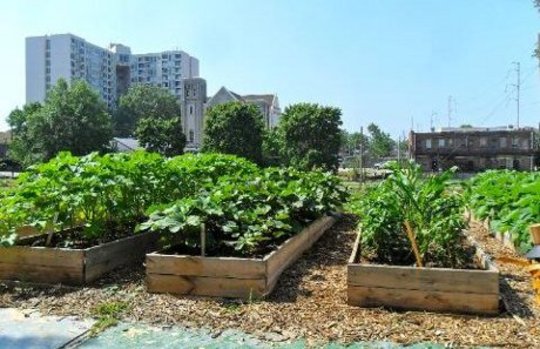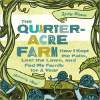
 he "Big City" allure that lured the farmer's children off the farm is changing. One only has to look at Detroit and similar rust belt cities with abandoned homes and overgrown lots to know the future will be different. With middle and low-income wages stagnating or declining, the 99%ers are calling attention to the income disparity that has overtaken America. They understand that the ticket to the "American Dream" punched by hard work and willingness to follow the rules has been reduced to confetti for many.
he "Big City" allure that lured the farmer's children off the farm is changing. One only has to look at Detroit and similar rust belt cities with abandoned homes and overgrown lots to know the future will be different. With middle and low-income wages stagnating or declining, the 99%ers are calling attention to the income disparity that has overtaken America. They understand that the ticket to the "American Dream" punched by hard work and willingness to follow the rules has been reduced to confetti for many.
While the system sorts things out, it is now necessary, more than ever, for individuals, families, and small community-based groups to help themselves. One of these sure-fired methods is the backyard garden. Also gaining popularity is the community garden. For many, gone are the days of a trip to Grandmother's farm for a visit where upon leaving, she loaded you up with fresh fruits and veggies, but some are beginning to reproduce the "rural setting" in the urban setting.
History Of Urban Farming
While urban farming is not a new concept, it is making a modern comeback. In 1893, Detroit mayor Haze S. Pingree asked his constituents to use any available space to plant gardens. The goal was income production and providing food and independence for Detroit citizens during that decade's depression. Then in WWI, President Wilson expanded that vision to include all of the USA, and by 1919, 500 million pounds of produce were harvested from over 5 million garden plots. During the Great Depression, subsistence gardens produced over 2.8 million dollars of food. World War II revived the concept under the name Victory Gardens, and 5.5 million Americans participated and grew over 9 million pounds of fruits and vegetables in one year, which amounted to 44% of all produce grown in the US at that time.
This concept has proved itself time and time again, and it seems that we are entering another phase where urban farming will be beneficial but perhaps necessary, as many find themselves either out of work or working at jobs that are paying much less than previously.
Social Benefits Of Urban Farming
The benefits of urban farming well surpass the nutrition aspect, though that is a major part of it. Urban garden plots can also provide increased income, employment, food for the household, decreased grocery expenditures, and a "common ground" for neighbors. It also puts to use vacant plots of land that have been useless for years and now regain productive use.
Community gardens have existed in many cities for years. Apart from bringing people together, it can also reduce the investment aspect of gardening as tools can be purchased for the group and shared. Also, each person can focus on one or two specialties, allowing them to exchange with their neighbors and sell their surplus. Not only that, but it can provide constructive and fulfilling activities for children, teens, and the elderly.
One section of the population practicing "urban" farming for years is the prison population. Many prisons have their gardens where they grow vegetables for their kitchens. This is a way of cutting costs and giving work to "idle hands." There are many benefits to working with one's hands in the soil, as it is a very calming, nurturing, and healing activity.
How to Create a Beautiful Edible Landscape
Terry's Square Foot Organic Vegetable Garden
Obsessives: Urban Farming
Novella Carpenter started small, with some plants in an empty lot next to her house in Oakland. A few years later, she tended to a full-blown farm with goats, turkeys, ducks, pigs, and a robust garden. This video tackles questions of neighborliness (which is more offensive: police sirens or roosters crowing?), environmental poisons (raised beds are key), and the all-important slaughter question. The answer: Yes, she does (and yes, there is some bloody footage).
{youtube}8yYO4L2vegE{/youtube}
Other Sources Of Information
http://www.urbanfarmonline.com/
Recommended Books:
 Urban Farming: Sustainable City Living in Your Backyard, in Your Community, and in the World by Thomas J. Fox.
Urban Farming: Sustainable City Living in Your Backyard, in Your Community, and in the World by Thomas J. Fox.
Urban Farming will introduce readers to gardening and farming from a high-rise apartment, participating in a community garden, vertical farming, and converting terraces and other small city spaces into fruitful vegetable real estate.
Click Here For More Info and/or Order On Amazon
The Urban Homestead (Expanded & Revised Edition): Your Guide to Self-Sufficient Living in the Heart of the City by Kelly Coyne and Erik Knutzen.
Step-by-step projects, tips, and anecdotes will help get you started homesteading immediately.
Click Here For More Info and/or Order On Amazon
 The Quarter-Acre Farm: How I Kept the Patio, Lost the Lawn, and Fed My Family for a Year by Spring by Warren and Jesse Pruet.
The Quarter-Acre Farm: How I Kept the Patio, Lost the Lawn, and Fed My Family for a Year by Spring by Warren and Jesse Pruet.
When Spring Warren told her husband and two teenage boys that she wanted to grow 75 percent of all the food they consumed for one year — and that she wanted to do it in their yard — they told her she was crazy. She did it anyway.
Click Here For More Info and/or Order On Amazon
About the Author
 Robert Jennings is co-publisher of InnerSelf.com with his wife Marie T Russell. He attended the University of Florida, Southern Technical Institute, and the University of Central Florida with studies in real estate, urban development, finance, architectural engineering, and elementary education. He was a member of the US Marine Corps and The US Army having commanded a field artillery battery in Germany. He worked in real estate finance, construction and development for 25 years before starting InnerSelf.com in 1996.
Robert Jennings is co-publisher of InnerSelf.com with his wife Marie T Russell. He attended the University of Florida, Southern Technical Institute, and the University of Central Florida with studies in real estate, urban development, finance, architectural engineering, and elementary education. He was a member of the US Marine Corps and The US Army having commanded a field artillery battery in Germany. He worked in real estate finance, construction and development for 25 years before starting InnerSelf.com in 1996.
InnerSelf is dedicated to sharing information that allows people to make educated and insightful choices in their personal life, for the good of the commons, and for the well-being of the planet. InnerSelf Magazine is in its 30+year of publication in either print (1984-1995) or online as InnerSelf.com. Please support our work.
Creative Commons 4.0
This article is licensed under a Creative Commons Attribution-Share Alike 4.0 License. Attribute the author Robert Jennings, InnerSelf.com. Link back to the article This article originally appeared on InnerSelf.com
ing































